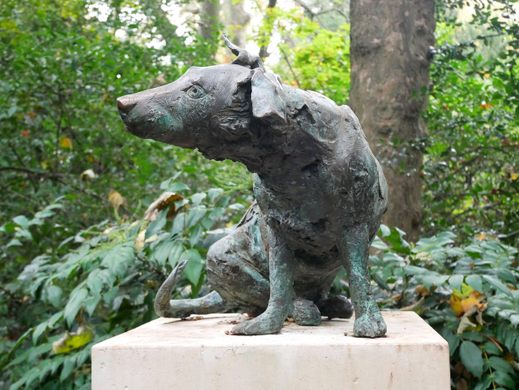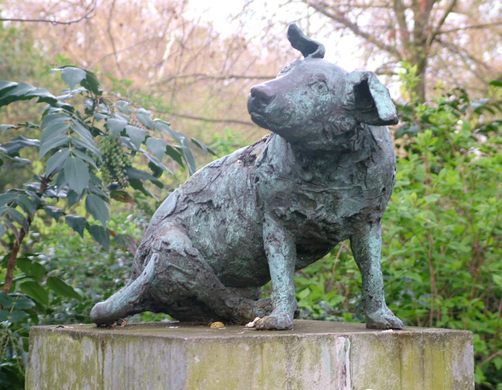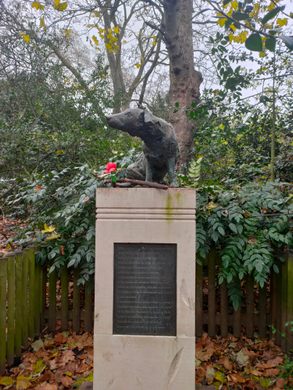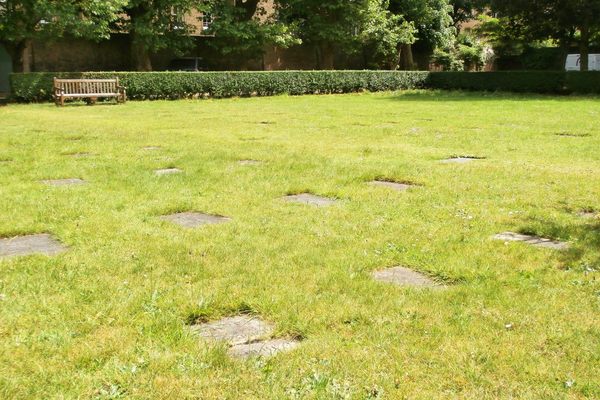AO Edited
Brown Dog Statue
A memorial to a dog that inspired rioting in the streets of London.
The Brown Dog Statue is, obviously, a nice and very handsome boy, yes he is. Less obvious, though, is the contentious political and scientific history he represents.
To understand the gravity of this winsome canine sculpture, we have to go back to 1903, when allegations of inhumane (and illegal) experimentation on a brown terrier at University College London caused an outrage. Although the medical professor in question won his ensuing libel case, the incident inspired a groundswell of support for the British anti-vivisection movement.
In response, the original Brown Dog Statue was erected in the London Metropolitan Borough of Battersea. A well-established center of progressive politics, Battersea was home to London’s only anti-vivisection hospital (which neither conducted animal experiments, nor employed physicians who approved of the practice) and thus was friendly territory for the statue and its supporters. The memorial featured a bronze sculpture of the now-infamous brown terrier, drinking fountains for humans and dogs alike, and an inscription that detailed the suffering of the pooch, called out University College London by name, and advocated for the abolition of such experimentation.
Medical students at UCL were incensed, arguing that the dog had been properly anaesthetized (possibly true), that no law had been broken (also possibly true), and that anti-vivisectionists were superstitious, sentimental idiots impeding The Advance of Science (incontrovertible proof that med students have been imperious and condescending since at least 1906). Additionally, they pointed out that these things happen at other universities, so maybe the inscription shouldn’t only reference UCL (fair enough).
After a year of grumbling, a group of medical students decided to take matters into their own hands by attacking the memorial with a crowbar and a sledgehammer. Though foiled by the round-the-clock police protection that had been assigned to the dog statue, the incident kicked off the Brown Dog Riots that saw medical students from various prestigious English universities clashing in the streets of Battersea with anti-vivisectionists, suffragettes, trade unionists, socialists, and other progressive factions, as well as fighting police in Trafalgar Square. The mainstream press was apparently largely supportive of the medical students, offering up mindblowing headlines like “Medical Students Gallant Fight with Women,” and dismissing the inscription as “hysterical language.”
Things finally cooled down in 1909, when a Conservative council was voted into power in Battersea. Tired of the ongoing controversy, the new government ripped the statue down under cover of night on March 10, 1910. Despite petitions and legal injunctions undertaken to restore it, the statue was hidden away in a blacksmith’s shed and ultimately destroyed.
However, the anti-vivisection movement remains active in the U.K., and the Brown Dog Affair remains an emblematic event in the history of the cause. Thus, in 1985—75 years after the removal of the original—a new Brown Dog Statue was erected in Battersea Park, and remains there today. Bearing the controversial inscription of the original, the new statue also honors the ongoing efforts to advocate for animal rights in a new era of scientific research.
Know Before You Go
The Brown Dog Statue is located on a pathway between the pump house and the Old English Garden in Battersea Park.
The statue is well hidden amongst the foliage. "Brown Dog Statute " can be found on Google Maps, making its location easier to find.

































Follow us on Twitter to get the latest on the world's hidden wonders.
Like us on Facebook to get the latest on the world's hidden wonders.
Follow us on Twitter Like us on Facebook